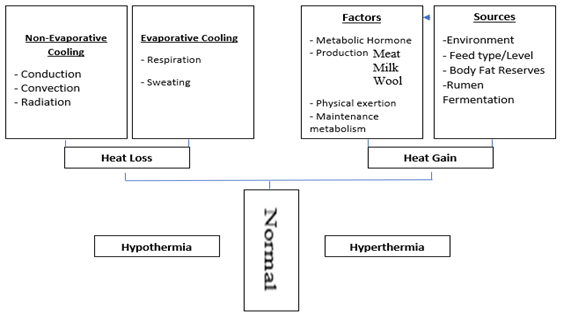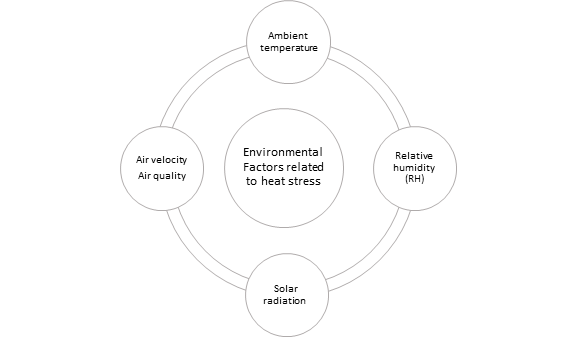Cattle are susceptible to heat stress, especially those kept on high levels of nutrition for the purpose of maximising growth rates, which leads to a significant heat increment in their bodies. Consequences include compromised health and productivity and mortalities during extreme events, as well as serious economic loss.
- body temperature
- heat stress
- hyperthermia
- infrared thermography
Note: The following contents are extract from your paper. The entry will be online only after author check and submit it.
1. Introduction
Welfare and productivity of cattle can be severely compromised in hot environments, especially for those kept in subtropical and tropical regions where animals are regularly exposed to high ambient temperature and/or relative humidity for prolonged periods [1]. In the literature, either “heat load” or “heat stress” are used to describe the animal’s suffering under hot conditions [2,3]. Cattle exposed to prolonged heat stress reduce their feed intake, milk production [4–6], growth and welfare [7], reproductive performance [8], health, and immunity. Consequences include serious economic loss and mortalities during extreme events [9,10]. Almost 20 years ago, In the US beef industry heat stress resulted in more than 300 million dollars of loss to the national economy [11]. In Australia, a 16.5-million-dollar loss to feedlot industry has been estimated over the summer period in 2006 [12] and more recently during 2019–2020, high temperatures cause not only heat stress but also bushfires affecting livestock industry, exact estimate awaited. Thermal acclimation to a heat stress event helps to maintain productivity but it is variable for different beef breeds, for example it has been reported as 9 and 14 days for Angus and Charolais, respectively [13].
The body temperature of animals increases in hot environmental conditions, including high humidity and/or high solar radiation, particularly when ambient temperature exceeds the upper critical temperature [14]. Animals suffering with these conditions attempt to cope by dissipating heat through different physiological means, that are coordinated by the hypothalamus [14,15]. These centre on heat dissipation from the surface of the skin through increased peripheral circulation, vasodilatation, and sweating [16].
The endocrine response to heat stress is mainly reflected in elevated glucocorticoids (cortisol), aldosterone, antidiuretic hormone, thyroxine, prolactin, and growth hormone (GH) [17,18]. The benefits of using faeces that has been discharged from the body as a suitable biological material for estimation of cortisol metabolites is that it provides a longer-term non-invasive approach, compared with conventional blood sampling, which is a short-term assessment and an invasive procedure, requiring handling of animals [19–21]. Higher plasma cortisol concentrations in cows were reported in earlier studies during acute heat stress conditions [22,23], but increased concentrations of cortisol metabolites in faeces have been shown in animals exposed to acute heat stress conditions [18].
Cattle core body temperature ranges from 38.0 to 39.3 °C during thermoneutral conditions [16,24]. Different methods are used for estimating core body temperature, by approaching through the rectum [24,25], vagina [26–28], tympanic membrane of the ear [29], rumen [3,30], or using infrared thermography of external body surfaces [31,32]. These all differ in their speed of response to heat stress, accuracy, and degree of invasiveness [33], and are discussed individually in this review.
Climate change means that cattle will be increasingly exposed to heat stress [34]. Economic losses, resulting from poor production performance of heat stressed animals, could be reduced by predicting the exact time for the implementation of corrective actions to manage the risk of heat stress. This could be accomplished through better understanding of the cattle responses during heat stress conditions. The measurement of faecal and hair cortisol hormone metabolites and infrared thermography of external body surfaces are among the most recent approaches, with the added advantage that they are non-invasive. We hypothesized that heat stress detection in cattle is supported by a growing literature that will eventually enable farmers to control this source of stress.
2. Stress Response to Hot Environment
Selye [35,36] demonstrated a common stress response, driven by the adrenal gland, to different stressors and defined stress as the biological responses upon exposure to an adverse environmental condition. The term “stressors” was used to define adverse environmental conditions. Stress does not always result in overall detrimental effects for animals [37], as this could be an indication for adaptation to a new environment [35].
Extreme environmental circumstances, hot or cold, are potential stressors [35]. In particular, high temperatures often lead to low productivity, lowered immune responses, high morbidity, and mortality. The exposure of animals with hot environmental conditions are described using one of the two terms either “heat load” and or “heat stress” [2,38]. Heat load would appear to be an indication of the levels of factors that are supplying the environmental impact on the animal and the heat stress is how the animal responds.
Heat stress affects cattle bioenergetics [17,39,40], and particularly afflicts rapidly growing beef cattle and high lactating cows because of their requirement for a high plane of nutrition and the significant heat increment arising from rumen fermentation [1]. Cattle respond to heat stress through increased heat dissipation [17] by physiological and behavioural thermoregulatory mechanisms [16,38,39]. These mechanisms involve increased heat dissipation through sweating and peripheral circulation, increased respiration, panting, and also reducing feed intake to lower metabolic heat [16].
3. Thermoregulatory Mechanism
In homeotherms, initial thermoregulatory response is to maintain and restore constant core body temperature, allowing heat to dissipate from the body through insensible and sensible thermal heat exchange. Insensible heat exchange also known as evaporative heat loss uses evaporation, that involves a vapour gradient for thermal heat exchange. Sensible thermal heat exchange also known as non-evaporative heat loss that involves heat loss through a thermal gradient. Sensible thermal heat exchange includes convection, conduction, and radiation [7]. Thermoregulatory mechanisms have already been reviewed in literature [7,41], however, for a quick review, these mechanisms are detailed here in Figure 1.
Figure 1. Thermoregulatory mechanisms adapted from Tait [41] and Yousef [42]
4. Environmental Factors Related to Heat Stress in Cattle
Environmental factors affecting cattle welfare due to heat stress include ambient temperature, relative humidity, and solar radiation, having direct or indirect impact on cattle welfare. Although brief exposure to hot environmental conditions may result an insignificant impact on production performance, during sustained exposure to hot conditions welfare problems can arise, especially for the high-producing dairy and feedlot cattle [17,43]. The animal’s climatic environment is complex, especially in outdoor conditions. The impact of environmental factors related to heat stress in cattle has already been reviewed in literature [44], however for a quick review, these factors are outlined in Figure 2.
Figure 2. Environmental factors related to heat stress in cattle.
This entry is adapted from the peer-reviewed paper 10.3390/ani11010071


